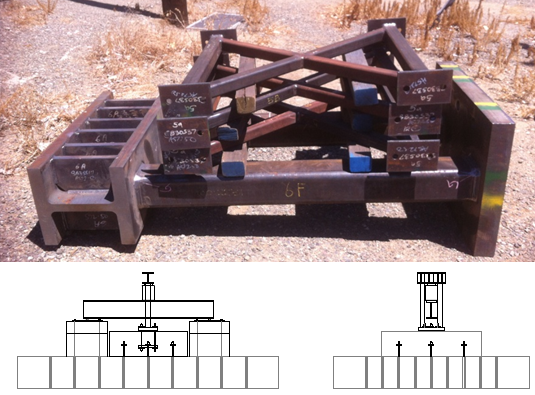| The experimental program consists of two distinct but related test programs. The first series of tests is focused on the behavior of steel column-to-foundation embedded connections when subjected to axial compression and reversed cyclic lateral loading. These loading simulations are geared at applying simultaneous gravity and earthquake loads characteristic of a first-story column in a Moment Resisting Frame. The second series examines the tensile capacity of anchorage assemblies used in ma. A high magnitude vertical force will be applied to induce breakout failure in a concrete block representative of a larger foundation. |
Reaction Frames |
| In order to successfully execute a comprehensive test matrix, including compressive and tensile loading, lateral loading, and high magnitude pull-out forces, multiple load frames and relatively sophisticated components were required. A rotating frame was designed to allow for over 200 tons of tensile and compressive forces to be delivered to the test specimen while maintaining a concentric line of action through the specimen centerline. The frame will be fixed to newly fabricated clevis joints, designed specifically to accommodate each loading scenario. An additional loading frame was constructed to provide a mechanism for applying up to 500 tons of tensile force to anchorage specimens; this is the amount anticipated to cause break-out failure. In total, approximately 48,000 pounds of steel was designed and fabricated to meet testing expectations. |
Embedded Connection Tests |
 A range of compressive and tensile forces representing gravity loads will be applied and held constant for each of test using a loading beam fastened at the mid-span to the top of the steel column. Hydraulic cylinders will connect to steel rods that are anchored into clevis joints mounted on reinforced concrete blocks. These joints and the mounting blocks act to allow the frame to pivot about a location level with the surface of the concrete specimen. The cyclic lateral loading will be applied roughly 9 feet above the concrete surface simulating the location of zero moment (point of inflection) for typical 1st story columns in Moment Resisting Frames. Lateral loads will be generated using a 220-kip actuator connected to a fabricated lateral loading frame. |
Anchorage Tests |
 A steel loading frame was constructed to deliver up to 500 tons of pull-out forces to anchorage specimens. The primary purpose of the anchorage assembly test program is to develop and disseminate fundamental understanding of the failure modes and force transfer mechanisms in anchor group details subjected to tension uplift. Anchorage configurations are based on various attempts by practicing professionals to design an efficient and conservative way to anchor 1st story columns to foundations without embedment. The proposed test setup is shown below. |
Test Matrix |
| The current test matrix and other project related documents are available for research team members and affiliates through Google Documents. |



